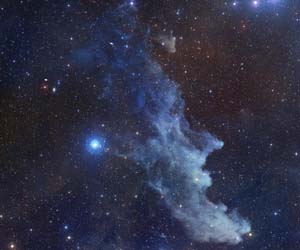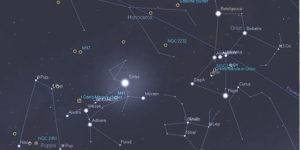Orion is the most-easily recognized constellation in the sky, which is no doubt due to its distinctive configuration, and the fact its constituent stars are very luminous. In fact, it includes two of the brightest stars in the entire sky, including Rigel, a magnificent bluish-white supergiant located 772.9 light years distant, and with an apparent magnitude of 0.13, making it the 7th brightest star in the entire night sky. Although Rigel appears as a single star in the bottom right corner of Orion, it is actually a binary star system consisting of Rigel A and Rigel B, the latter of which cannot be seen by the unaided eye.
Quick Facts
Coordinates: RA 05h 14m 32.3s/Dec 08° 12′ 06″
Star Type: Class B Supergiant (B8Ia)
Constellation: Orion
Distance: 772.9 light years
Apparent Mag: 0.13 (0.05 – 0.18)
Luminosity: 100,000 solar luminosity
Surface Temperature: 12,000C (22,000F)
Mass: 17 solar masses
Radius: 33.73 million miles (78 solar radii)
Rotational Velocity: 25 km/s
Age: 8 million years old
Other Names: Rigel, Algebar, Elgebar, Beta Ori,
Best Seen
Orion can be seen in the northern hemisphere from late autumn to early spring, and in the southern hemisphere in the summer months. Its brightest star, Rigel, reaches its highest elevation on the 12th of December and on the 24th of January each year, when it can be seen in both hemispheres since it is located on the celestial equator. This fact makes it one of the most important navigational stars in the sky, since it can be seen in all of the world’s oceans and seas, except for areas within 8 degrees of the North Pole.
Notable Stars
Star Facts: Rigel
Rigel is accepted to have evolved off the main sequence, and some investigators estimate that it has lost as much as 3 solar masses of material during is short life of only 7 to 9 million years. It is expected that Rigel will eventually end its life in a type II supernova explosion, providing the material for future star formation. The two main components of this binary star system are Rigel A and Rigel B.
– Rigel A: This is a blue-white supergiant with an absolute magnitude of -7.84. The appellation “supergiant” is no exaggeration, either, as Rigel A has roughly 24 times the mass of the Sun, it shines 120,000 brighter, and is 80 times as big as the result of it swelling up, having depleted its hydrogen fuel supply.
– Rigel B: The other component(s) of the system, Rigel B, is actually a binary system in itself, with a separation of more than 2,200 AU between Rigel A and Rigel B. This separation translates into a distance of 12 light days, so it is perhaps not surprising that no orbital motion has been observed, even though the components of the system share the same proper motion trajectory. Both members of Rigel B are B9V-class blue-white main sequence stars, having 2.5 and 1.9 times the mass of the Sun respectively. However, the components of Rigel B are about 500 times less luminous than Rigel A, which can sometimes make it challenging to spot the pair in small telescopes, although magnifications of around 150× with 7-inch instruments will usually show Rigel B in good seeing conditions.
Visibility
Witch Head NebulaDespite having the Bayer designation “beta”, Rigel is almost always more luminous than Alpha Orionis (Betelgeuse). The star is currently moving through a nebulous area of space, and as a result its light is being reflected off several nearby dust and gas clouds, one notable example being the eerie blue glow of IC 2118 (Witch Head Nebula). See the image below: Since Rigel falls close to our line of sight of the Orion Nebula, it is often associated with it, but the fact is that the Orion Nebula is almost twice as far away from Earth as Rigel.
Despite the huge difference in their respective distances, Rigel is considered a member of the Taurus-Orion R1 Association, which is reserved for recently- formed stars that are located closer to the Orion Nebula.
Variability
Rigel was recognized as an Alpha Cygni variable in 1998, basically meaning that some parts of its stellar surface are contracting at the same time as others areas are expanding. As a result, the apparent magnitude of Rigel varies from between 0.05 – 0.18, with a major driving force behind its variability being the nuclear fusion processes that take place in the star’s outer layers, where hydrogen is being converted. This process seems to be influenced by the helium conversion process that takes place in the core, thus producing at least some of the observed variations in luminosity.
History
In the ancient Arabic tradition, the Orion figure was known as “Jauzah”, which gave rise to an alternative name for Rigel, “rigl al-gabbar”, which meant “The Foot of the Great One”. This in turn served as the origin for several more alternative names, among which were the now-obsolete Algebar, and Elgebar. The first mention of the star using the name “Rigel”, dates back to 1252, when it appeared in astronomical tables sponsored by King Alfonso X of Castile, known as the Alfonsine Tables.
In south-western Australia, the Wotjobaluk Koori people knew Rigel as Yerrerdet-kurrk, the mother-in-law of Totyerguil (Altair), with the distance between the two stars symbolizing the taboo of a man approaching his mother-in-law too closely. In northern Australia, the Wardaman people knew Rigel as Unumburrgu, The Red Kangaroo Leader, and as such, the chief conductor and MC of all ceremonies when Orion is high above the horizon. In this tradition, all the other stars in Orion are the tools and entourage of the Red Kangaroo Leader, with Ya-jungin (Betelgeuse), known as “Owl Eyes Flicking”, keeping an eye on proceedings.



